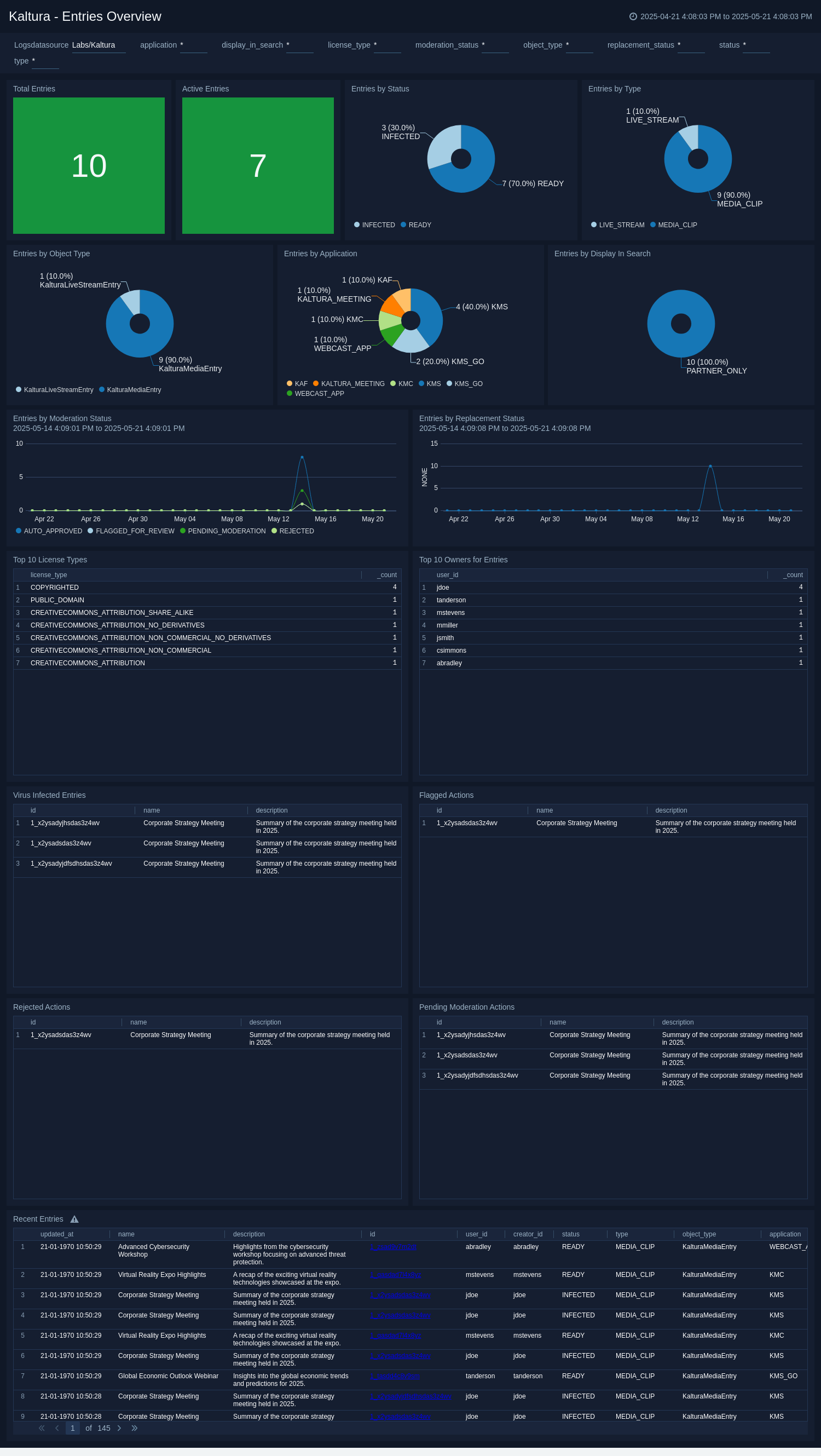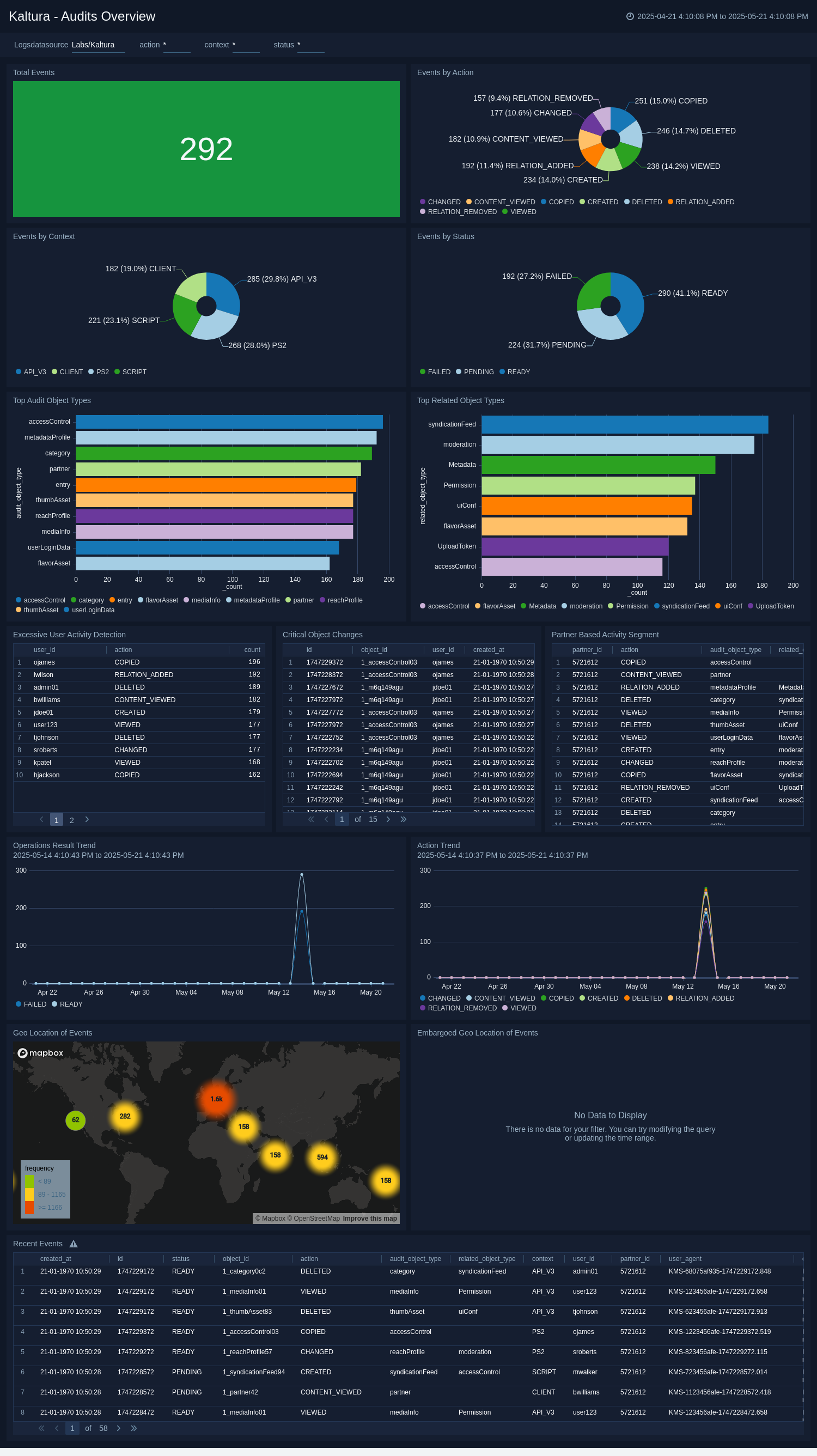Kaltura

The Sumo Logic app for Kaltura offers a comprehensive overview of key metrics within the content management ecosystem, including total entries, user activity trends, and event distributions. It provides visualizations and analytics to help you monitor trends, detect changes, and optimize your content strategies, enabling you to make informed decisions and maintain the security of the platform.
This app includes built-in monitors. For details on creating custom monitors, refer to the Create monitors for Kaltura app.
Log types
This app uses Sumo Logic’s Kaltura Source to collect the base entry events and the audit trail events from the Kaltura platform.
Sample log messages
Audit Trail Event Log
{
"id": 1747229372,
"createdAt": 1747229372,
"status": 2,
"auditObjectType": "accessControl",
"objectId": "1_accessControl03",
"entryId": "1_accessControl03",
"masterPartnerId": 5721612,
"partnerId": 5721612,
"requestId": "627081177",
"userId": "ojames",
"action": "COPIED",
"data": {
"changedItems": [
{
"descriptor": "accessControl.TYPE",
"oldValue": "restricted",
"newValue": "unrestricted",
"objectType": "KalturaAuditTrailChangeItem"
},
{
"descriptor": "accessControl.RULE",
"oldValue": "ruleA",
"newValue": "ruleB",
"objectType": "KalturaAuditTrailChangeItem"
}
],
"objectType": "KalturaAuditTrailChangeInfo"
},
"ks": "djJ8NTcyMTYxMnz4000R7odJuJvBFHRM1tsCApuOv-61TnUTXSrSkNRtVdPzuahbx1bkWLP9BfvHxh0wKUV9wlIf1-So-elhmMAageO_XNNFhsQtPNI4x0mpV4PXj1MaDuPqPRQ2sw5f4DevBxdfyEzwMtj8kBRCPts5TLfiEiXSFvhVpsBT_2qdNM4Kz91sSYAzzmVE6XPBIJsxw6Nx-G2Ee0bIVROBV0v19q5GuJK5RA7MU4bggbbvh31T0dpguRGxxVn7LKfD2JGAGJcqY63CMfSbdm6k2nS8iCrMzhwaP5PqC8edsh8IZLejhKyJ6Qf2nopwg0JN17phVuFsgmR6",
"context": 1,
"entryPoint": "accessControl::copy",
"serverName": "nvp1-fapi-rty9",
"ipAddress": "193.124.185.120",
"userAgent": "KMS-1223456afe-1747229372.519",
"clientTag": "KMS 5.150.13, build 0;1223456afe;nvp1-mediaspace-kms-main-777979b8f8-w7kct",
"objectType": "KalturaAuditTrail"
}
Base Entry Event Log
{
"id": "1_qasdad7l4x8yz",
"name": "Virtual Reality Expo Highlights",
"description": "A recap of the exciting virtual reality technologies showcased at the expo.",
"partnerId": 5721612,
"userId": "mstevens",
"creatorId": "mstevens",
"tags": "VR, technology, expo",
"adminTags": "expo_highlights",
"categories": "Technology",
"categoriesIds": "458901234",
"status": 2,
"moderationStatus": 6,
"moderationCount": 0,
"type": 1,
"createdAt": 1747229272,
"updatedAt": 1747229272,
"rank": 4.4,
"totalRank": 44,
"votes": 10,
"downloadUrl": "https://jaromivaxenox.xyz/p/5721612/sp/0/playManifest/entryId/1_q7l4x8yz/format/download/protocol/https/flavorParamIds/0",
"searchText": "_PAR_ONLY_ _5721612_ _MEDIA_TYPE_1| Virtual Reality Expo Highlights",
"version": 1,
"thumbnailUrl": "https://jaromivaxenox.xyz/p/5721612/sp/0/thumbnail/entry_id/1_q7l4x8yz/version/100011",
"accessControlId": 7294800,
"referenceId": "VRExpo2025",
"replacementStatus": 0,
"partnerSortValue": 150,
"conversionProfileId": 25121350,
"rootEntryId": "1_q7l4x8yz",
"operationAttributes": [],
"entitledUsersEdit": "mstevens,rgarcia",
"entitledUsersPublish": "rgarcia",
"entitledUsersView": "mstevens,rgarcia,awilliams",
"capabilities": "",
"displayInSearch": 1,
"blockAutoTranscript": false,
"plays": 80,
"views": 110,
"width": 1920,
"height": 1080,
"duration": 3000,
"msDuration": 3000000,
"mediaType": 1,
"conversionQuality": 25121350,
"sourceType": "4",
"dataUrl": "https://jaromivaxenox.xyz/p/5721612/sp/0/playManifest/entryId/1_q7l4x8yz/format/url/protocol/https",
"flavorParamsIds": "489001,489002",
"objectType": "KalturaMediaEntry",
"application": 0,
"licenseType": 4
}
Sample queries
_sourceCategory="Labs/Kaltura" accessControlId
| json "id", "status", "type", "objectType", "application", "displayInSearch", "moderationStatus", "replacementStatus", "licenseType", "userId", "name", "description", "creatorId", "dataUrl", "updatedAt" as id, status, type, object_type, application, display_in_search, moderation_status, replacement_status, license_type, user_id, name, description, creator_id, data_url, updated_at nodrop
| where !isNull(application) and !isNull(license_type)
| lookup status_name as status from https://sumologic-app-data.s3.us-east-1.amazonaws.com/kaltura/kaltura_status_mapping.csv on status=status_code
| lookup type_name as type from https://sumologic-app-data.s3.us-east-1.amazonaws.com/kaltura/kaltura_type_mapping.csv on type=type_code
| lookup application_name as application from https://sumologic-app-data.s3.us-east-1.amazonaws.com/kaltura/kaltura_application_mapping.csv on application=application_code
| lookup display_search_name as display_in_search from https://sumologic-app-data.s3.us-east-1.amazonaws.com/kaltura/kaltura_display_search_mapping.csv on display_in_search=display_search_code
| lookup moderation_status_name as moderation_status from https://sumologic-app-data.s3.us-east-1.amazonaws.com/kaltura/kaltura_moderation_status_mapping.csv on moderation_status=moderation_status_code
| lookup replacement_status_name as replacement_status from https://sumologic-app-data.s3.us-east-1.amazonaws.com/kaltura/kaltura_replacement_status_mapping.csv on replacement_status=replacement_status_code
| lookup license_type_name as license_type from https://sumologic-app-data.s3.us-east-1.amazonaws.com/kaltura/kaltura_license_type_mapping.csv on license_type=license_type_code
| where status matches "{{status}}"
| where type matches "{{type}}"
| where application matches "{{application}}"
| where display_in_search matches "{{display_in_search}}"
| where moderation_status matches "{{moderation_status}}"
| where replacement_status matches "{{replacement_status}}"
| where license_type matches "{{license_type}}"
| where object_type matches "{{object_type}}"
| count by id, status
| count by status
| sort by _count, status
Collection configuration and app installation
Depending on the set up collection method, you can configure and install the app in three ways:
- Create a new collector and install the app. Create a new Sumo Logic Cloud-to-Cloud (C2C) source under a new Sumo Logic Collector and later install the app, or
- Use an existing collector and install the app. Create a new Sumo Logic Cloud-to-Cloud (C2C) source under an existing Sumo Logic Collector and later install the app, or
- Use existing source and install the app. Use your existing configured Sumo Logic Cloud-to-Cloud (C2C) source and install the app.
Use the Cloud-to-Cloud Integration for Kaltura to create the source and use the same source category while installing the app. By following these steps, you can ensure that your Kaltura app is properly integrated and configured to collect and analyze your Kaltura data.
Create a new collector and install the app
To set up collection and install the app, do the following:
Next-Gen App: To install or update the app, you must be an account administrator or a user with Manage Apps, Manage Monitors, Manage Fields, Manage Metric Rules, and Manage Collectors capabilities depending upon the different content types part of the app.
- Select App Catalog.
- In the 🔎 Search Apps field, run a search for your desired app, then select it.
- Click Install App.
note
Sometimes this button says Add Integration.
- In the Set Up Collection section of your respective app, select Create a new Collector.
- Collector Name. Enter a Name to display the Source in the Sumo Logic web application. The description is optional.
- Timezone. Set the default time zone when it is not extracted from the log timestamp. Time zone settings on Sources override a Collector time zone setting.
- (Optional) Metadata. Click the +Add Metadata link to add a custom log Metadata Fields. Define the fields you want to associate, each metadata field needs a name (key) and value.
 A green circle with a checkmark is shown when the field exists and is enabled in the Fields table schema.
A green circle with a checkmark is shown when the field exists and is enabled in the Fields table schema. An orange triangle with an exclamation point is shown when the field doesn't exist, or is disabled in the Fields table schema. In this case, you'll see an option to automatically add or enable the nonexistent fields to the Fields table schema. If a field is sent to Sumo Logic but isn’t present or enabled in the schema, it’s ignored and marked as Dropped.
An orange triangle with an exclamation point is shown when the field doesn't exist, or is disabled in the Fields table schema. In this case, you'll see an option to automatically add or enable the nonexistent fields to the Fields table schema. If a field is sent to Sumo Logic but isn’t present or enabled in the schema, it’s ignored and marked as Dropped.
- Click Next.
- Configure the source as specified in the
Infobox above, ensuring all required fields are included. - In the Configure section of your respective app, complete the following fields.
- Field Name. If you already have collectors and sources set up, select the configured metadata field name (eg _sourcecategory) or specify other custom metadata (eg: _collector) along with its metadata Field Value.
- Click Next. You will be redirected to the Preview & Done section.
Post-installation
Once your app is installed, it will appear in your Installed Apps folder, and dashboard panels will start to fill automatically.
Each panel slowly fills with data matching the time range query received since the panel was created. Results will not immediately be available but will be updated with full graphs and charts over time.
Use an existing collector and install the app
To set up the source in the existing collector and install the app, do the following:
Next-Gen App: To install or update the app, you must be an account administrator or a user with Manage Apps, Manage Monitors, Manage Fields, Manage Metric Rules, and Manage Collectors capabilities depending upon the different content types part of the app.
- Select App Catalog.
- In the 🔎 Search Apps field, run a search for your desired app, then select it.
- Click Install App.
note
Sometimes this button says Add Integration.
- In the Set Up Collection section of your respective app, select Use an existing Collector.
- From the Select Collector dropdown, select the collector that you want to set up your source with and click Next.
- Configure the source as specified in the
Infobox above, ensuring all required fields are included. - In the Configure section of your respective app, complete the following fields.
- Field Name. If you already have collectors and sources set up, select the configured metadata field name (eg _sourcecategory) or specify other custom metadata (eg: _collector) along with its metadata Field Value.
- Click Next. You will be redirected to the Preview & Done section.
Post-installation
Once your app is installed, it will appear in your Installed Apps folder, and dashboard panels will start to fill automatically.
Each panel slowly fills with data matching the time range query received since the panel was created. Results will not immediately be available but will be updated with full graphs and charts over time.
Use an existing source and install the app
To skip collection and only install the app, do the following:
Next-Gen App: To install or update the app, you must be an account administrator or a user with Manage Apps, Manage Monitors, Manage Fields, Manage Metric Rules, and Manage Collectors capabilities depending upon the different content types part of the app.
- Select App Catalog.
- In the 🔎 Search Apps field, run a search for your desired app, then select it.
- Click Install App.
note
Sometimes this button says Add Integration.
- In the Set Up Collection section of your respective app, select Skip this step and use existing source and click Next.
- In the Configure section of your respective app, complete the following fields.
- Field Name. If you already have collectors and sources set up, select the configured metadata field name (eg _sourcecategory) or specify other custom metadata (eg: _collector) along with its metadata Field Value.
- Click Next. You will be redirected to the Preview & Done section.
Post-installation
Once your app is installed, it will appear in your Installed Apps folder, and dashboard panels will start to fill automatically.
Each panel slowly fills with data matching the time range query received since the panel was created. Results will not immediately be available but will be updated with full graphs and charts over time.
Viewing Kaltura dashboards
All dashboards have a set of filters that you can apply to the entire dashboard. Use these filters to drill down and examine the data to a granular level.
- You can change the time range for a dashboard or panel by selecting a predefined interval from a drop-down list, choosing a recently used time range, or specifying custom dates and times. Learn more.
- You can use template variables to drill down and examine the data on a granular level. For more information, see Filtering Dashboards with Template Variables.
- Most Next-Gen apps allow you to provide the scope at the installation time and are comprised of a key (
_sourceCategoryby default) and a default value for this key. Based on your input, the app dashboards will be parameterized with a dashboard variable, allowing you to change the dataset queried by all panels. This eliminates the need to create multiple copies of the same dashboard with different queries.
Entries Overview
The Kaltura - Entries Overview dashboard provides a detailed view of content management metrics, including total and active entries, categorized by status, type, application, and moderation status. Using visualizations like pie charts and bar graphs, it helps you track entry distribution, identify trends, and optimize content strategies. Insights into virus-infected entries, flagged actions, and top license types support informed decision-making and help maintain data integrity within the Kaltura platform.

Audits Overview
The Kaltura - Audits Overview dashboard provides a clear view of audit trail data, highlighting key metrics like total events, actions, and contextual details. Visualizations such as pie charts and bar graphs display event distributions by action, context, status, and critical object changes. You can identify anomalies, monitor user behavior, and improve security by analyzing trends, user activity, and geographical data. The dashboard supports informed decision-making and helps optimize auditing processes within the Kaltura platform.

Create monitors for Kaltura app
From your App Catalog:
- From the Sumo Logic navigation, select App Catalog.
- In the Search Apps field, search for and then select your app.
- Make sure the app is installed.
- Navigate to What's Included tab and scroll down to the Monitors section.
- Click Create next to the pre-configured monitors. In the create monitors window, adjust the trigger conditions and notifications settings based on your requirements.
- Scroll down to Monitor Details.
- Under Location click on New Folder.
note
By default, monitor will be saved in the root folder. So to make the maintenance easier, create a new folder in the location of your choice.
- Enter Folder Name. Folder Description is optional.
tip
Using app version in the folder name will be helpful to determine the versioning for future updates.
- Click Create. Once the folder is created, click on Save.
Kaltura monitors
| Name | Description | Trigger Type (Critical / Warning / MissingData) | Alert Condition |
|---|---|---|---|
Events from Embargoed Locations | This alert is triggered when events originating from embargoed locations are detected, ensuring adherence to security restrictions and protocols. | Critical | Count > 0 |
Infected Entry Detected | This alert is triggered when entries are marked and flagged as infected, indicating potential security threats and content integrity issues. | Critical | Count > 0 |
Virus Scan Failed Entry Detected | This alert is triggered when virus scans fail on entries, highlighting vulnerabilities and possible malware presence within the platform. | Critical | Count > 0 |
Critical Object Changes | This alert is triggered when critical changes occur in essential object types, ensuring system integrity and security. | Critical | Count > 0 |
Upgrade/Downgrade the Kaltura app (Optional)
To update the app, do the following:
Next-Gen App: To install or update the app, you must be an account administrator or a user with Manage Apps, Manage Monitors, Manage Fields, Manage Metric Rules, and Manage Collectors capabilities depending upon the different content types part of the app.
- Select App Catalog.
- In the Search Apps field, search for and then select your app.
Optionally, you can identify apps that can be upgraded in the Upgrade available section. - To upgrade the app, select Upgrade from the Manage dropdown.
- If the upgrade does not have any configuration or property changes, you will be redirected to the Preview & Done section.
- If the upgrade has any configuration or property changes, you will be redirected to the Setup Data page.
- In the Configure section of your respective app, complete the following fields.
- Field Name. If you already have collectors and sources set up, select the configured metadata field name (eg _sourcecategory) or specify other custom metadata (eg: _collector) along with its metadata Field Value.
- Click Next. You will be redirected to the Preview & Done section.
Post-update
Your upgraded app will be installed in the Installed Apps folder and dashboard panels will start to fill automatically.
See our Release Notes changelog for new updates in the app.
To revert the app to a previous version, do the following:
- Select App Catalog.
- In the Search Apps field, search for and then select your app.
- To version down the app, select Revert to < previous version of your app > from the Manage dropdown.
Uninstalling the Kaltura app (Optional)
To uninstall the app, do the following:
- Select App Catalog.
- In the 🔎 Search Apps field, run a search for your desired app, then select it.
- Click Uninstall.